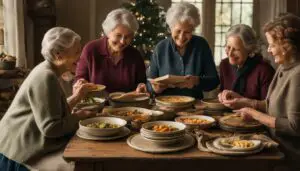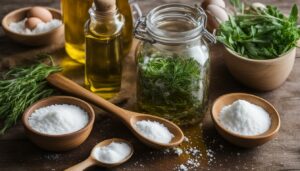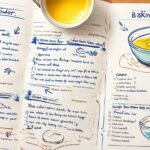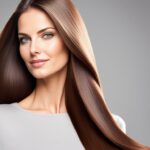Originally posted on February 10, 2024 @ 7:10 am
Cooking is not only an art but also a science. It involves precise measurements, careful observations, and systematic processes. Have you ever wondered how recipes and science procedures align? In this article, we will delve into the fascinating similarities between these two seemingly different domains.
Recipes are more than just a list of ingredients and instructions. They are a roadmap to creating a culinary masterpiece. Similarly, science procedures follow a systematic approach to investigate and understand the natural world. By drawing parallels between recipes and scientific methods, we can uncover the hidden connections between these two disciplines.
Whether you are a passionate home cook or a curious food enthusiast, exploring the intersection of recipes and science can broaden your understanding of the culinary world. So, let’s dive in and discover how culinary experiments and the scientific method intertwine in the captivating realm of cooking.
Contents
- 1 The Role of Recipes in Culture and Human Diet
- 2 The Science Behind RecipeDB
- 3 The Similarities Between Recipe Development and Scientific Method
- 4 Using Technology to Enhance Recipe Discovery and Development
- 5 The Importance of Recipe Testing and Iteration
- 6 The Art of Recipe Writing and Documentation
- 7 Challenges and Considerations in Recipe Development and Commercialization
- 8 Conclusion
- 9 FAQ
- 9.1 How are recipes and science procedures similar?
- 9.2 What is the role of recipes in culture and human diet?
- 9.3 How does RecipeDB integrate scientific research and experimentation?
- 9.4 How do recipe development and scientific method align?
- 9.5 How does technology enhance recipe discovery and development?
- 9.6 Why is recipe testing and iteration important?
- 9.7 How important is recipe writing and documentation?
- 9.8 What are the challenges in recipe development and commercialization?
- 9.9 What are the concluding thoughts on recipes and scientific procedures?
- 10 Source Links
Key Takeaways:
- Recipes and science procedures share many similarities, including precise measurements, systematic approaches, and documentation of processes.
- Understanding the scientific aspects of recipes can provide insights into taste preferences, nutrition, and health.
- Technological advancements in recipe development have revolutionized the way recipes are discovered, personalized, and shared.
- Recipe testing and iterative refinement are crucial steps in creating delicious and safe culinary creations.
- Well-written recipe instructions and clear documentation are essential for recreating dishes and protecting intellectual property rights.
The Role of Recipes in Culture and Human Diet
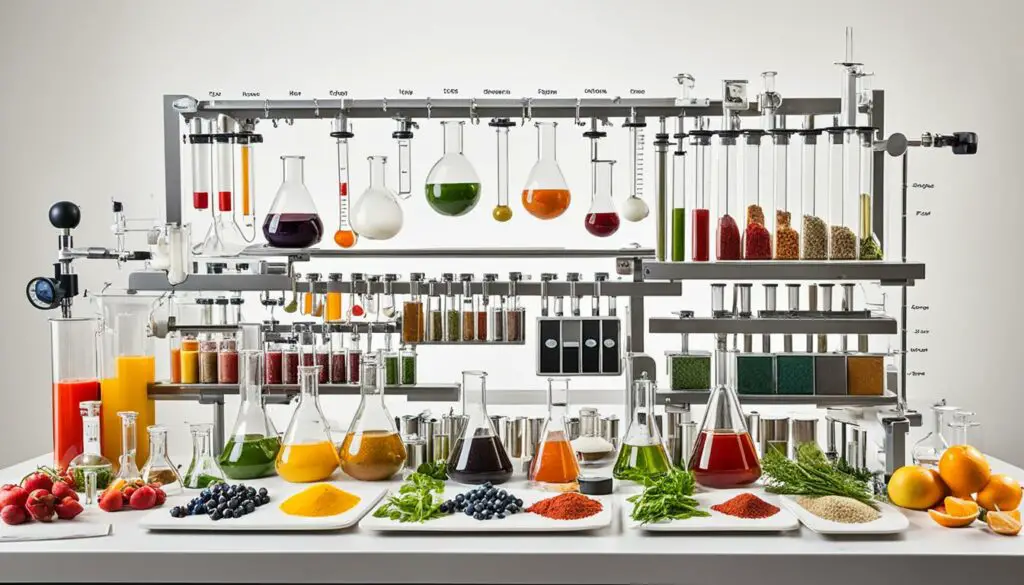
Cooking is not only a process of transforming ingredients into delicious meals, but it also holds cultural significance and contributes to human well-being. In fact, cooking has played a crucial role in our development as a species.
Throughout history, recipes have been passed down from generation to generation, serving as cultural capsules that preserve culinary traditions and knowledge. These recipes not only provide instructions for preparing specific dishes but also embody the cultural identity of a community.
The cultural significance of recipes extends beyond taste and flavor. Recipes reflect the dietary practices and preferences of different societies, providing insights into their history, geography, and social norms.
Recipes serve as cultural capsules that transmit the knowledge of food transformation and dietary practices across generations.
Moreover, recipes have a profound impact on our taste preferences. The flavors and combinations found in recipes shape our palates and influence our choices when it comes to food.
Recipe development is not just an art; it is a scientific process. Behind every recipe is a series of culinary experiments, where chefs and home cooks explore the properties of ingredients, the chemical reactions involved in cooking, and the sensory experiences they create.
Scientific research has shown that cooking involves various scientific concepts, such as heat transfer, protein denaturation, and flavor chemistry. Understanding these scientific principles can empower us to become better cooks and make informed decisions about our diets.
The Cultural Significance of Recipes
Recipes are unique cultural artifacts that reflect the values, traditions, and beliefs of a community. They provide an opportunity to delve into the rich tapestry of human history and explore the diverse culinary traditions that have evolved over time.
Recipes not only preserve traditional dishes, but they also adapt and evolve as cultures mix and interact. Through recipes, we can trace the influences of migration, trade, and colonization on culinary traditions, creating a deeper understanding and appreciation of different cultures.
| Cultural Region | Signature Dish |
|---|---|
| Italy | Pasta Carbonara |
| India | Chicken Tikka Masala |
| Mexico | Tacos al Pastor |
| China | Kung Pao Chicken |
Recipes also serve as a way to connect with our roots and preserve our cultural heritage. For immigrants or individuals living in a different country, cooking traditional recipes can provide a sense of comfort, nostalgia, and connection to their homeland.
The Science Behind Cooking
Cooking is not just an art; it is also a scientific process. Culinary science encompasses a wide range of disciplines, including food chemistry, sensory analysis, and nutritional science.
Understanding the scientific principles behind cooking can help us achieve better culinary results. For example, understanding the Maillard reaction, which occurs when proteins and sugars react at high temperatures, can help us brown meats and create delicious caramelized flavors.
Additionally, understanding the nutritional content of ingredients and cooking methods can empower us to make healthier choices in the kitchen. By learning about the chemical composition of foods and how different cooking techniques affect their nutritional value, we can optimize our diets for better health outcomes.
Exploring the cultural and scientific aspects of recipes allows us to appreciate the culinary world in a new light. From the cultural significance of different dishes to the scientific principles that govern cooking, recipes provide a window into the intricacies of food and its impact on human well-being.
The Science Behind RecipeDB
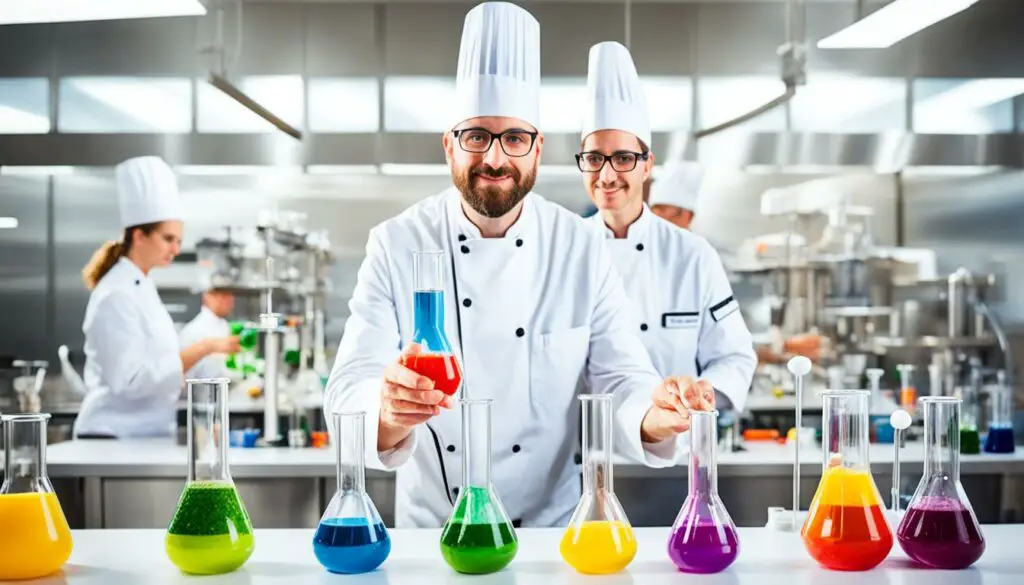
RecipeDB is a structured repository of recipes, ingredients, cooking processes, and dietary styles. It integrates data from various sources, including flavor profiles, nutritional information, and disease associations. By dissecting recipes into their culinary elements and linking them to health and flavor attributes, RecipeDB facilitates scientific exploration in the culinary space. It provides a comprehensive overview of recipes from different cuisines, regions, and countries, enabling researchers to study the interplay between taste, nutrition, and health.
Culinary Research and Experimentation
RecipeDB serves as a valuable resource for culinary research and experimentation. With its extensive database, researchers can find recipes that align with their specific objectives or explore culinary traditions from around the world. The scientific approach to cooking is enhanced through access to diverse recipes with detailed information on ingredients, cooking methods, and flavor profiles.
Scientific Approach to Cooking
RecipeDB promotes the scientific approach to cooking by providing a platform for chefs, scientists, and food enthusiasts to analyze and experiment with recipes. The integration of nutritional information and disease associations allows for a deeper understanding of the impact of ingredients and cooking techniques on health outcomes. By leveraging this scientific approach, RecipeDB unlocks new possibilities for developing innovative and nutritious culinary creations.
With RecipeDB, culinary research is no longer confined to the boundaries of the kitchen. It opens up a world of possibilities for exploring the interplay between taste, nutrition, and health, paving the way for culinary discoveries and advancements in the field.
The Similarities Between Recipe Development and Scientific Method

Recipe development and scientific method share striking parallels in their approach. Both processes involve generating ideas, selecting ingredients, testing and adjusting variables, and documenting the final outcomes. Just as scientists conduct experiments to analyze and understand natural phenomena, chefs and recipe developers experiment with flavors, techniques, and ingredients to create innovative dishes.
Like scientific analysis, culinary experiments require systematic observation, data collection, and analysis to evaluate the impact of different variables on the final taste and presentation of a dish. Chefs meticulously fine-tune their recipes by examining how varying quantities, cooking methods, and ingredient combinations affect the sensory experience, mouthfeel, and overall enjoyment of the meal. Through this process of trial and error, chefs are constantly exploring the boundaries of taste and pushing culinary boundaries.
“Experimentation is the essence of both cooking and scientific exploration. Both endeavors thrive on curiosity, creativity, and a desire to discover new possibilities.”
The systematic approach of the scientific method can be effectively applied to recipe development, enhancing the understanding and reproducibility of culinary creations. By following a structured process that involves defining the problem, formulating a hypothesis, designing experiments, and analyzing the results, chefs can optimize their recipes based on evidence-based insights.
The combination of scientific analysis in cooking and culinary experimentation opens up a world of possibilities, allowing chefs to innovate and reimagine traditional dishes. By examining the similarities between recipes and scientific procedures, we gain a deeper appreciation for the art and science of cooking.
The Power of Culinary Experiments
Culinary experiments are the driving force behind culinary innovation and gastronomic evolution. They enable chefs to create unique sensory experiences by combining unexpected ingredients or employing unconventional cooking techniques. By venturing beyond the boundaries of traditional recipes, chefs can push the culinary envelope and create extraordinary dishes that captivate the imagination and tantalize the taste buds.
| Parallels Between Recipes and Scientific Procedures | Culinary Experiments: An Art and Science |
|---|---|
| Both involve generating ideas | Experimentation is the essence of both cooking and scientific exploration |
| Both require selecting ingredients | Culinary experiments allow chefs to explore flavor combinations and ingredient interactions |
| Both involve testing and adjusting variables | Chefs fine-tune recipes through trial and error to achieve the desired taste and presentation |
| Both rely on systematic observation and analysis | Scientific analysis in cooking enables chefs to evaluate the impact of different variables on taste and mouthfeel |
| Both aim to document the final outcomes | Chefs record recipe adjustments and successes to ensure reproducibility and refinement |
Using Technology to Enhance Recipe Discovery and Development

Technology has become an indispensable tool in the culinary world, revolutionizing recipe discovery and development. The advancements in data science and natural language processing have opened up new possibilities for home cooks and professional chefs alike. With the help of cutting-edge technology, recipe databases have evolved into comprehensive platforms, providing personalized recommendations, dietary customization, and even image-based recipe retrieval.
One of the notable technological advancements in recipe development is the implementation of data science techniques. By analyzing vast amounts of recipe data, algorithms can identify patterns and correlations, uncovering hidden insights that can enhance culinary creations. This data-driven approach to recipe development allows for the creation of healthier and more nutritious dishes, as well as the discovery of innovative flavor combinations.
A key area where technology has made a significant impact is recipe recommendation systems. These systems leverage user preferences, historical data, and machine learning algorithms to suggest recipes tailored to individual tastes. They consider factors such as dietary restrictions, ingredient availability, and cooking skills to present users with a curated selection of recipes that align with their preferences and requirements.
“Technology has made it easier than ever for home cooks to find healthy recipes, customize meals based on dietary needs, and explore new culinary horizons.”
Moreover, technology enables personalized meal planning, allowing individuals to create customized menus that cater to their specific dietary goals and preferences. These meal planning tools take into account nutritional requirements, portion sizes, and ingredient availability to streamline the meal preparation process and promote healthier eating habits.
Image-based recipe retrieval is another exciting innovation that harnesses the power of technology. With this technology, users can simply snap a photo of a dish to retrieve the corresponding recipe. Natural language processing algorithms analyze the image and match it with similar dishes in the recipe database, providing users with step-by-step instructions and ingredient lists. This feature is particularly useful when encountering new and unfamiliar dishes during travel or dining experiences.
“The integration of technology in recipe development has paved the way for a more accessible and personalized culinary experience.”
The potential of technology in recipe discovery and development is vast. From providing real-time ingredient substitutions and sourcing information to optimizing cooking times and temperatures, technology has streamlined and enhanced the entire culinary process. As further advancements are made, we can expect even greater integration of technology in the kitchen, bringing forth new possibilities and transforming the way we create, share, and enjoy recipes.
Benefits of Technology-Enhanced Recipe Development
There are numerous benefits that arise from using technology to enhance recipe development:
- Improved accessibility to a wide range of recipes, catering to diverse dietary needs.
- Enhanced precision in ingredient measurements and cooking techniques, resulting in consistent and reproducible dishes.
- Opportunities for recipe customization and adaptation based on personal preferences and dietary restrictions.
- Promotion of healthier eating habits through personalized meal planning and nutritional analysis.
- Efficient utilization of ingredients, reducing food waste and promoting sustainability.
“Technology has transformed recipe development into an interactive and dynamic process, empowering individuals to explore their culinary curiosity and create unique dishes.”
Comparison of Traditional Recipe Development and Technology-Enhanced Recipe Development
| Aspect | Traditional Recipe Development | Technology-Enhanced Recipe Development |
|---|---|---|
| Access to Recipe Database | Dependent on personal collection or cookbooks | Access to comprehensive online databases and recommendation systems |
| Recipe Customization | Time-consuming and manual adjustment of ingredients and measurements | Personalized recommendations and customization based on dietary needs and preferences |
| Ingredient Substitutions | Dependent on personal knowledge and experimentation | Real-time ingredient substitution suggestions based on availability and dietary restrictions |
| Cooking Techniques | Relies on personal experience and trial-and-error | Optimized cooking techniques and precise instructions for consistent results |
| Meal Planning | Manual planning and estimation of nutritional values | Personalized meal planning based on nutritional requirements and portion sizes |
As the table demonstrates, technology-enhanced recipe development offers numerous advantages over traditional methods, including access to vast recipe databases, personalized recommendations, ingredient substitutions, optimized cooking techniques, and efficient meal planning. These advancements streamline the recipe development process, making it more accessible, precise, and adaptable to individual needs.
The Importance of Recipe Testing and Iteration

In the world of culinary experimentation and recipe development, testing and iteration play crucial roles. Recipe testing is a critical step in the process, ensuring that recipes not only taste delicious but are also visually appealing and feasible to prepare. It is through testing that chefs and recipe developers are able to refine their recipes, make necessary adjustments, and achieve consistent and exceptional results.
Recipe testing goes beyond the realm of taste and aesthetics; it also contributes to food safety. By carefully testing recipes, chefs can determine the appropriate cooking times and temperatures to prevent foodborne illnesses. This attention to detail ensures that every dish served meets the highest standards of quality and safety.
“The iterative process of testing and refining recipes leads to culinary excellence and customer satisfaction.”
Throughout the testing process, feedback from testing panels is invaluable. These individuals provide valuable insights and perspectives, enabling chefs and recipe developers to fine-tune their recipes based on real-world experiences. By listening to feedback and making necessary adjustments, recipes can be refined to perfection.
Recipe testing is an iterative process, with each round of testing bringing chefs and recipe developers closer to culinary excellence. Through multiple iterations, recipes can be refined, flavors can be balanced, techniques can be improved, and ingredients can be maximized for their full potential.
Ultimately, recipe testing and iteration are essential for achieving culinary greatness and ensuring customer satisfaction. By investing time and effort into this process, chefs and recipe developers can deliver exceptional dishes that delight the palate and create memorable dining experiences.
The Benefits of Recipe Testing and Iteration
- Ensuring Taste Perfection: Recipe testing allows chefs to fine-tune flavors, balancing them to create a harmonious taste experience.
- Optimizing Techniques: Through testing and iteration, chefs can improve cooking techniques, resulting in better texture and consistency.
- Enhancing Visual Appeal: Recipe testing helps chefs create visually stunning dishes that are irresistible to the eye.
- Ensuring Feasibility: Testing recipes ensures that they are feasible to prepare, taking into account time, resources, and equipment.
- Promoting Food Safety: The testing process helps determine proper cooking times and temperatures to prevent foodborne illnesses.
- Consistency and Reproducibility: Through testing, chefs ensure that their recipes yield consistent results, regardless of who prepares them.
By understanding the importance of recipe testing and embracing the iterative nature of recipe development, chefs and recipe developers can refine their craft, create extraordinary dishes, and bring joy to countless food enthusiasts.
The Art of Recipe Writing and Documentation
Well-written recipes are essential for recreating dishes and sharing culinary creations. Clear and concise instructions, along with visual representations of the finished dish, make recipes accessible and easy to follow. Headings, bullet points, and images help break down recipes into clear steps, highlighting important information. Proper documentation and organization of recipes not only enhance reproducibility but also protect intellectual property rights for professional chefs, food bloggers, and other food industry professionals.
Clear Instructions for Success
When writing a recipe, it’s crucial to provide clear instructions that leave no room for confusion. Use simple language and avoid using jargon or complex culinary terms unless necessary. Break down the cooking process into individual steps, ensuring that each step is logically organized and easy to follow. By providing precise measurements, cooking times, and temperatures, you can empower home cooks to recreate your dishes with confidence.
Visual Representation of Recipes
Using visual aids, such as images, can greatly enhance the clarity of a recipe. Including high-quality photographs or illustrations of the finished dish allows readers to visualize the desired outcome. This visual representation helps readers gauge the dish’s appearance and compare it to their own progress during the cooking process.
Formatting and Organization
Proper formatting and organization significantly contribute to the readability and usability of a recipe. Utilize headings, subheadings, and bullet points to break down the recipe into distinct sections and emphasize key information. This not only makes it easier for readers to navigate the recipe but also enables them to scan for specific details quickly.
“A well-organized recipe with clear instructions ensures that anyone, regardless of their culinary expertise, can successfully recreate a dish.”
The Importance of Intellectual Property
For professional chefs, food bloggers, and individuals in the food industry, protecting their original recipes is essential. By documenting recipes in a clear and detailed manner, including unique flavor combinations and cooking techniques, they can establish intellectual property rights. This safeguards their culinary creations from unauthorized use and ensures that their creative efforts are recognized and respected.
Challenges and Considerations in Recipe Development and Commercialization
As with any creative endeavor, recipe development and commercialization bring forth a set of challenges that must be navigated. Various factors, such as the intended audience, cuisine type, recipe purpose, dietary restrictions, time, and resources, significantly impact the development process. It is crucial to address these challenges proactively to ensure the success of a recipe in the market.
To create a marketable recipe, one must strive to offer something unique or appealing to a broad audience. Catering to popular trends, accommodating dietary restrictions, or showcasing innovative flavor combinations can increase the recipe’s marketability. However, it’s essential to strike a balance between creativity and accessibility. Recipes that involve complex techniques, require unusual ingredients, or have long preparation times may limit their appeal to a wider audience.
The marketability of a recipe extends beyond its flavor profile and appearance. It also entails considering the demand for specific cuisines, cultural influences, and regional preferences. Conducting market research and understanding consumer trends can inform recipe development decisions and increase the chances of success. Adapting recipes to suit different dietary lifestyles, such as vegan, gluten-free, or low-carb, can broaden their market potential.
Selling or licensing recipes to food businesses and writing cookbooks are potential avenues for monetizing recipes. However, before embarking on these ventures, careful consideration of market demand and originality is crucial. Creating a cookbook that caters to a specific niche audience or collaborating with food businesses that align with the recipe’s ethos can enhance its marketability and commercial potential.
Let’s take a look at the challenges and considerations in recipe development and commercialization:
| Challenges | Considerations |
|---|---|
| Intended audience | Market demand |
| Cuisine type | Originality |
| Recipe purpose | Accessibility |
| Dietary restrictions | Adapting to trends |
| Time and resources | Navigating competition |
The challenges and considerations in recipe development and commercialization require a delicate balance between creative innovation, market demand, and practicality. By addressing these factors thoughtfully, recipe developers can maximize the marketability of their creations and increase their chances of success in the culinary landscape.
Conclusion
Exploring the similarities between recipes and scientific procedures provides valuable insights into the culinary world. Recipes act as cultural capsules, preserving culinary wisdom and influencing taste preferences, nutrition, and health. By employing the systematic approach of the scientific method, recipe development can be enhanced, leading to better understanding and reproducibility.
Technological advancements have revolutionized the way recipes are discovered and developed. Through data science and natural language processing, personalized meal planning and recipe recommendation systems have become possible. These innovations cater to specific dietary needs and enable home cooks to customize recipes according to individual preferences.
Recipe testing plays a crucial role in the development process, ensuring that dishes are not only delicious but also safe to consume. Feedback from testing panels helps chefs and recipe developers refine their creations, leading to culinary excellence and customer satisfaction. Clear and concise recipe writing, accompanied by visual aids, makes recipes accessible and easy to follow.
Recognizing the parallels between recipes and science allows us to deepen our appreciation for the art and science of cooking. From cultural significance to technological advancements, the culinary landscape continues to evolve, offering endless opportunities for creativity and exploration.
FAQ
How are recipes and science procedures similar?
Recipes and science procedures share similarities in their approach, both involving the generation of ideas, selection of ingredients, testing and adjusting variables, and careful documentation of the process and final results.
What is the role of recipes in culture and human diet?
Recipes serve as cultural capsules that transmit knowledge of food transformation and dietary practices across generations, shaping taste preferences and having implications for nutrition and health.
How does RecipeDB integrate scientific research and experimentation?
RecipeDB is a comprehensive database that integrates global recipes, cooking processes, ingredients, flavor profiles, and nutritional information, facilitating scientific exploration in the culinary space by linking recipes to health and flavor attributes.
How do recipe development and scientific method align?
Recipe development, like scientific method, involves experimenting with flavors, techniques, and ingredients to create new dishes. The systematic approach of the scientific method can be applied to recipe development, enhancing understanding and reproducibility.
How does technology enhance recipe discovery and development?
Technological advancements, such as data science and natural language processing, have enabled the creation of recipe recommendation systems, personalized meal planning, and image-based recipe retrieval, revolutionizing the way recipes are created, shared, and customized.
Why is recipe testing and iteration important?
Recipe testing ensures that recipes are delicious, visually appealing, feasible to prepare, and safe to consume. Feedback from testing panels helps fine-tune recipes, make necessary adjustments, and ensure consistent results, leading to culinary excellence and customer satisfaction.
How important is recipe writing and documentation?
Well-written recipes with clear and concise instructions, visual representations of the finished dish, and proper organization make recipes accessible and easy to follow. Recipe writing and documentation enhance reproducibility and protect intellectual property rights for professional chefs and food industry professionals.
What are the challenges in recipe development and commercialization?
Factors such as intended audience, cuisine type, recipe purpose, dietary restrictions, time, and resources impact the development process. Recipes need to be marketable, offering something unique or appealing to a broad audience, while considering market demand and originality.
What are the concluding thoughts on recipes and scientific procedures?
Recognizing the parallels between recipes and scientific procedures deepens our appreciation for the art and science of cooking, while integrating scientific approaches in recipe development enhances understanding, reproducibility, and the exploration of taste, nutrition, and health.



